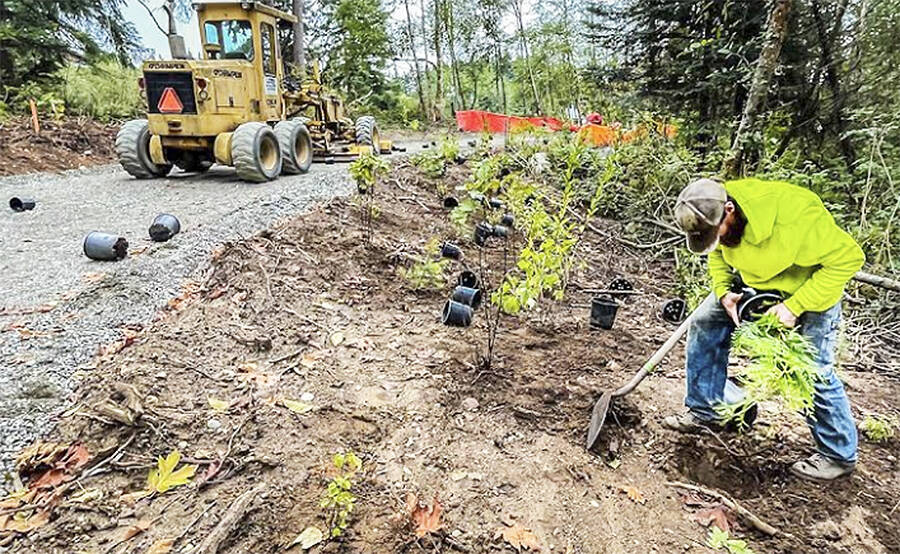City staff tried to follow Bainbridge Island City Council environmental values in changing development of the nonmotorized transportation plan for Eagle Harbor Drive.
Chris Wierzbicki, public works director, said it also would save money.
But in this instance, the council voted down that idea. City manager Blair King is going to plan a public meeting to get input.
Wierzbicki said next to Highway 305 it’s the busiest stretch of road on the island. Previous versions of the Eagle Harbor plan included separated trails, 7-foot-wide trails and a bridge, which would cost another $2 million.
The new plan, which needed $600,000 more, would have had an 8-12 foot path on one side of the road, so walkers and bicyclists would go in both directions. On the road would be traffic calming devices, crosswalks and narrowed streets to slow traffic.
Wierzbicki said the new plan would use 30% less asphalt and would have less impact on wetlands, shorelines and trees. It would require fewer permits and land acquisitions.
Michael Pollock, deputy mayor, said while he appreciated staff considering environmental options, trails need to be on both sides of the road.
Councilmember Kirsten Hytopoulos agreed cyclists would want some separation. “We need to build it for experienced and novice cyclists.”
Councilmember Christy Carr was more concerned about crossings, “Not just for 12-year-olds, but for myself.”
Mayor Rasham Nassar agreed with that. “Bike commuters wouldn’t use it to cross the road.”
Councilmember Leslie Schneider wondered if one side of the road could be for “cyclists who really want to barrel through.”
Carr also expressed concern that nonmotorized connections to this area doesn’t support this project. “We should look at the bigger piece, not just segments.”
Regarding the big picture, Hytopoulos said the city should look at a land swap with Greenlight Auto to provide even more options.
But she said the public must be frustrated with this project taking so long, and, “We’ve got lots and lots of miles to go.”
The current project, which would include only 5-foot paved shoulders on both sides of the road, is funded at $1.4 million (including $735,000 of federal grants). The recommended project would cost approximately $2 million and would more closely meet standards for all ages and abilities. The project needs to be completed by 2024 to meet federal grant obligations.
Census
The council heard a report on the latest census. BI now has a population of 24,825. The highest population is at the Northeast and the lowest in the Southeast. In the 10 years, BI grew by 1,800 people, or almost 8%.
Port Orchard grew the most at almost 40%, while Poulsbo grew 30%.
About 85% of the people on BI are white, with almost 3.5% Asian. The largest increase in the decade was for people identifying as two or more races: from 897 in 2010 to 2,234 in 2020.
Nov. 3 trail opening
Nearly 200 native trees and 180 native shrubs were planted last week along the new Sakai Connector Trail. Paving was scheduled for this week (weather permitting), and then the trail will be opened for public use.
A grand opening celebration will take place Nov. 3 at noon. The gathering will be at the High School Road and Highway 305 intersection. When completed, this segment of the Sound to Olympics Trail will provide a convenient connection from that intersection, through the trails in Sakai Park, up to Madison Avenue.
Tax exemption
At the Oct. 26 council meeting, it will continue to discuss a Multifamily Property Tax Exemption to encourage affordable housing development in Winslow and Lynwood Center in exchange for a partial tax relief for 12 or 20 years.
On Oct. 12, the City Council approved a motion to establish the maximum household incomes for the 12-year and 20-year program at 80% Area Median Income for units designated as affordable. The tax burden would then be shifted to and divided among other property taxpayers on Bainbridge Island.
Biennial budget
The council approved a budget for 2022 late in the fall of 2020 to which administration is now proposing modifications of approximately $1.8 million. A public hearing will take place at the Oct. 26 council meeting.
Highlights include:
*Sales and use tax 1-10th of 1% revenue – Council authorized an incremental sales and use tax to be used for funding affordable housing and mental and behavioral health-related facilities so the sales tax rate on the island will increase from 9% to 9.1%. This will be effective Jan. 1, 2022.
*Positions for management analyst, National Urban Fellowship intern, Housing specialist, Housing Action Plan and Maintenance worker
Property tax
The City Council scheduled a public hearing for Oct. 26 to receive feedback on the city’s 2022 property tax levy. This is an important step in budgeting, as property tax represents the single-largest tax revenue to the city, which receives roughly 9 cents of every dollar.



